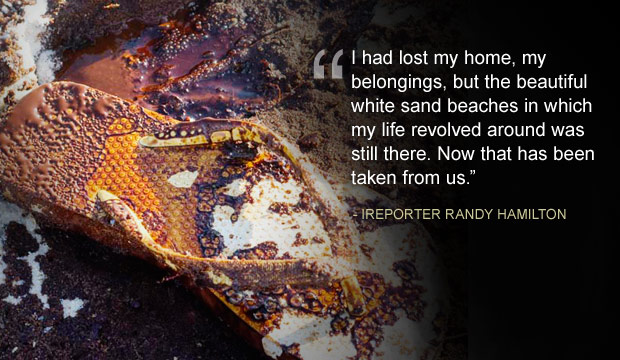A solitary flip-flop sits in the white sand of Pensacola, Florida, with chunky bits of goo spilled on top and to the side like chocolate sauce. The large amount of oil that washed on shore June 23 had just marred the coastline. Randy Hamilton spots the sandal, captures a photo and files it in his archives as specimen 359. Just another lost shoe for his collection of forgotten footwear photos, but this one is different. It speaks to yet another crisis in his land and in his life.
Hamilton still remembers when Hurricane Ivan came through the region in 2004 and changed everything. His Pensacola house was irreparably damaged by the storm, so he and his wife decided to hit the road for life in a motor home. The graphic designer and photographer didn’t want a permanent home, and one year on the road ultimately turned to four. Shortly after taking off in the motor home, he started a project called the One Shoe Diaries to showcase the photos and stories of finding unmatched shoes wherever he went. The first shoe was from Pensacola when he returned briefly to inspect his damaged house. The website brought him national attention and provided him with an outlet to share updates on the upcoming birth of baby son Noah.
The couple eventually returned to Pensacola to put down roots and prepare for Noah’s birth. When the child was stillborn, the shoes website provided a source of therapy and comfort. Then, another big change entered their lives, the birth of a healthy baby girl, Nora. Hamilton tries to take a photo of his “rainbow baby” just about every day.
Now that the oil disaster has come to the Gulf Coast, he sees its effects through his daughter’s eyes.
“Especially with a newborn child, I’m like, ‘Will she be able to see these things the way I saw them? Is it going to be toxic for her?’ ”
Hamilton said he views the photo of the oil-stained flip-flop as a metaphor for the region as a whole:
“The white sand is completely like our tourist industry, stained and oiled…That day that I went out there with the flip-flop was probably the worst. It was in, like, puddles, which drove me nuts because there were all these crews standing around.”
Photo 360 was another flip-flop on the beach, this one pink. Even though the oil is less visible now, he says he can dig through the sand and find tar balls and other evidence of local effects.
“It’s almost surreal. It almost does not sound like it could be real,” he said. “It’s devastating. It makes my heart sink.”
But Hamilton has weathered many storms and remains hopeful.
“This isn’t our first tragedy. It’s not our first rodeo; you know what I’m saying? But it’s still pretty devastating.”
This blog post is part of a series of profiles of Gulf Coast residents and visitors directly affected by the oil disaster. If you’d like to share your story, you can upload photos and videos to CNN iReport.
Posted by: nsaidi // July 9, 2010
Category: stories, oil_disaster

